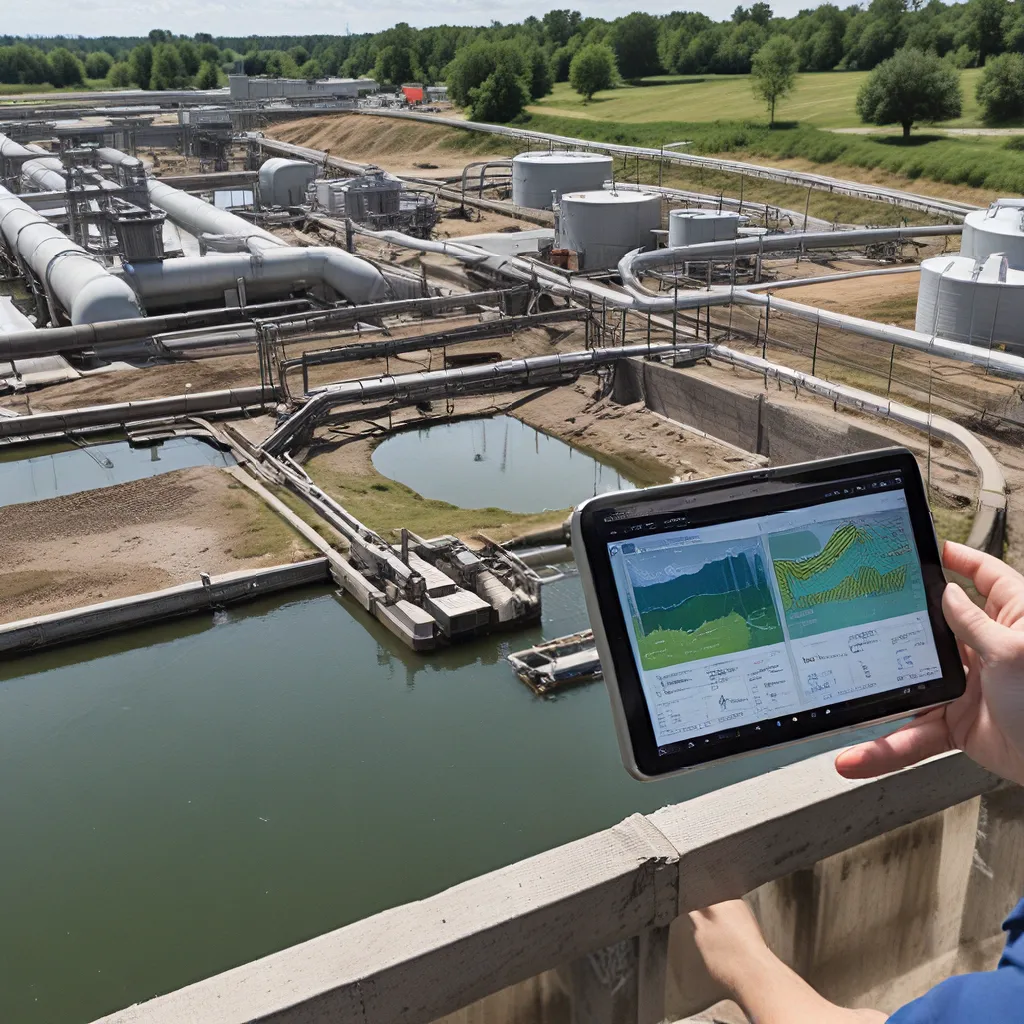
Imagine stepping into a bustling wastewater treatment plant, the hum of machinery and the flow of water creating a symphony of sustainable operations. But what if I told you that the real magic happens not on the factory floor, but in the digital realm? Welcome to the world of wastewater treatment and augmented reality (AR) dashboards, where the future of process optimization and compliance is unfolding before our eyes.
Demystifying Wastewater Treatment
As someone who’s never set foot in a wastewater treatment facility, I’ll admit, the idea of “wastewater treatment” conjures up images of a grimy, complex operation – something best left to the experts. But the reality is far more fascinating. Wastewater treatment is a critical component of the water cycle, responsible for taking used water from our homes, businesses, and industries and transforming it into a resource that can be safely returned to the environment.
The process involves a series of physical, chemical, and biological steps designed to remove contaminants, reduce energy consumption, and ensure the treated water meets strict regulatory standards. From sedimentation and aeration to disinfection and nutrient removal, each stage plays a vital role in creating a clean, environmentally-friendly effluent.
But the true challenge lies in managing these complex systems efficiently and effectively. That’s where augmented reality dashboards come into the picture, offering wastewater treatment plant operators a powerful tool to visualize and optimize their operations.
Embracing the AR Revolution in Wastewater
Imagine a world where you can monitor your plant’s performance from the palm of your hand, or even from the comfort of your own home. That’s the promise of augmented reality dashboards in the wastewater industry.
These cutting-edge interfaces merge the physical and digital realms, allowing operators to see critical data and process information overlaid onto their real-world environment. Gone are the days of huddling around a static control room display; with AR, the information comes to you, no matter where you are in the facility.
Human-Machine Interfaces (HMIs) have long been the backbone of industrial process control, but AR-powered dashboards take this concept to the next level. These high-performance HMIs are designed to minimize clutter, highlight only the most essential indicators, and provide a seamless, intuitive user experience.
Imagine being able to troubleshoot a malfunctioning pump by simply pointing your smartphone at it and seeing real-time performance data, maintenance schedules, and even step-by-step repair instructions. Or visualizing the flow of wastewater through the treatment process, with color-coded pipes and tanks that dynamically update to reflect the system’s status.
Industrial and municipal wastewater treatment facilities are highly complex, with numerous power-intensive applications that must adhere to strict regulatory standards. By leveraging AR dashboards, operators can improve energy efficiency, enhance process control, and ensure compliance with a level of insight and responsiveness that was previously unimaginable.
Unlocking the Power of Data Visualization
At the heart of these AR dashboards lies a treasure trove of data, collected from the various sensors and control systems throughout the wastewater treatment plant. But raw data is only as valuable as the insights it can provide.
That’s where data visualization comes into play. By presenting process information in intuitive, easy-to-understand formats, AR dashboards empower operators to quickly identify trends, diagnose issues, and make data-driven decisions.
Gone are the days of sifting through endless spreadsheets or struggling to decipher complex process diagrams. With AR, key performance indicators (KPIs), process variables, and alarm conditions are displayed in clear, customizable visualizations that can be tailored to the specific needs of each user.
Imagine being able to spot a spike in energy consumption or detect an impending equipment failure simply by glancing at a dynamic graph or gauge. These insights can then be used to optimize energy usage, schedule preventive maintenance, and ensure regulatory compliance – all from the convenience of a smartphone or tablet.
Bridging the Gap Between Physical and Digital
One of the most exciting aspects of AR dashboards in wastewater treatment is their ability to bridge the gap between the physical and digital realms. By seamlessly integrating real-time data with the tangible equipment and processes on the factory floor, these interfaces empower operators to make informed decisions with unprecedented speed and accuracy.
Wastewater treatment companies that have embraced AR technology are already reaping the benefits. Reduced downtime, improved energy efficiency, and enhanced regulatory compliance are just a few of the tangible outcomes that these innovative systems have delivered.
But the true power of AR dashboards lies in their ability to transform the way we interact with and understand our wastewater treatment infrastructure. By visualizing complex processes in an intuitive, engaging manner, these cutting-edge interfaces are paving the way for a new era of process optimization and sustainability.
The Future of Wastewater Treatment: Endless Possibilities
As I step back and reflect on the incredible potential of AR dashboards in the wastewater industry, I can’t help but feel a sense of excitement and wonder. This technology is not just about fancy graphics and flashy displays; it’s about revolutionizing the way we approach the challenge of sustainable water management.
Imagine a future where a single operator, armed with an AR-enabled tablet, can remotely monitor and control an entire wastewater treatment network, responding to changes in real-time and optimizing the system for maximum efficiency. Or picture virtual reality simulations that allow engineers to test and refine new process designs before a single shovel hits the ground.
The possibilities are truly endless, and the innovations in this space are only just beginning. As researchers and engineers continue to push the boundaries of AR and data visualization, I have no doubt that the wastewater treatment industry will be at the forefront of this technological revolution.
So the next time you flush the toilet or turn on the tap, take a moment to appreciate the unsung heroes who work tirelessly to ensure our water is clean, our environment is protected, and our communities thrive. And remember, the future of wastewater treatment is being written in the digital realm, one AR dashboard at a time.